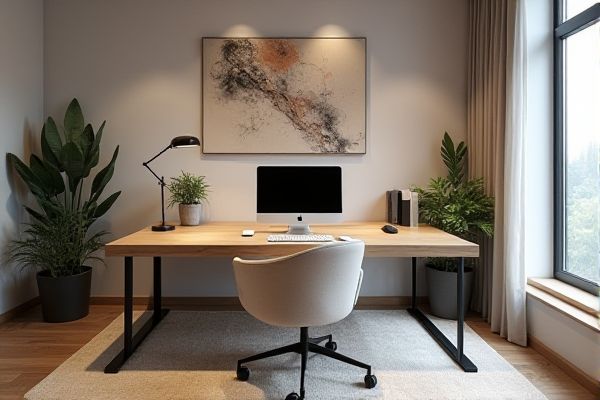
Choosing between a U-shaped desk and an L-shaped desk depends on your workspace needs, with U-shaped desks offering more surface area and storage, while L-shaped desks provide a compact and efficient corner setup ideal for multitasking. Explore this article to discover which desk style best enhances Your productivity and office organization.
Table of Comparison
| Feature | U-Shaped Desk | L-Shaped Desk |
|---|---|---|
| Shape | Three connected surfaces forming a U shape | Two connected surfaces forming an L shape |
| Workspace | Ample, surrounds user on three sides | Moderate, extends along two walls |
| Footprint | Larger, requires more room | Compact, fits smaller spaces |
| Usage | Ideal for multitasking and multiple monitors | Suitable for home office or smaller tasks |
| Storage Options | Often includes built-in cabinets or shelves | May include limited storage or add-ons |
| Ergonomics | Allows easy access to multiple work zones | Provides straightforward workspace setup |
| Cost | Generally higher, due to size and complexity | More affordable and budget-friendly |
Introduction: U-Shaped Desk vs L-Shaped Desk
U-shaped desks provide extensive workspace by surrounding the user on three sides, ideal for multitasking and organization, while L-shaped desks maximize corner space to enhance room layout and ergonomics. The U-shaped design suits larger offices needing multiple work zones, whereas L-shaped desks fit compact spaces with efficient use of floor area. Both styles improve productivity, but choice depends on space availability and specific work requirements.
Space Requirements and Room Fit
U-shaped desks require more floor space, making them ideal for larger rooms where maximizing workspace and storage is essential. L-shaped desks fit efficiently into corners, optimizing your room layout by utilizing often underused corner areas, perfect for medium to small spaces. Your choice depends on available room dimensions and how much surface area you need for tasks and equipment.
Design and Aesthetics
U-shaped desks offer a powerful, immersive layout that maximizes surface area and creates a commanding workspace, ideal for multitasking and organization. L-shaped desks provide a sleek, corner-friendly design that optimizes small spaces while maintaining an open, minimalist appearance. Both desk types blend functionality with style, but the U-shaped design delivers a more enveloping ambiance, whereas the L-shaped desk emphasizes space efficiency and modern aesthetics.
Workspace Efficiency and Workflow
U-shaped desks maximize workspace efficiency by providing ample surface area and easy access to multiple zones without excessive movement, ideal for multitasking and organizing tools within arm's reach. L-shaped desks optimize workflow by fitting neatly into corners, offering a streamlined layout that separates work areas for focused tasks while maintaining an open feel. Choosing between the two depends on room size and task requirements, with U-shaped designs excelling in comprehensive multitasking environments and L-shaped desks enhancing productivity in compact spaces.
Storage Options and Organization
U-shaped desks offer extensive storage options with multiple drawers and shelves on three sides, maximizing your organization potential by keeping office supplies within easy reach. L-shaped desks provide ample surface area combined with efficient use of corner space, often featuring built-in cabinets or filing drawers that help maintain a tidy workspace. Your choice between the two should consider how much storage capacity you need and the layout of your room to ensure optimal organization.
Comfort and Ergonomics
U-shaped desks offer superior comfort and ergonomics by providing ample surface area that allows users to easily access multiple work zones without excessive stretching or twisting, promoting better posture. L-shaped desks maximize corner space and encourage ergonomic positioning by supporting a natural arm angle and enabling easy swivel between tasks, reducing strain on the neck and shoulders. Choosing between U-shaped and L-shaped desks ultimately depends on workspace size and the need for multi-directional accessibility to enhance overall comfort and productivity.
Usage Scenarios: Home Office vs Corporate
U-shaped desks are ideal for corporate environments requiring extensive workspace and multitasking, offering ample surface area for multiple monitors, documents, and collaboration tools. L-shaped desks suit home offices by maximizing corner space, providing efficient workflow with dedicated zones for computer use and paperwork, making them perfect for smaller rooms. Both designs enhance productivity but cater to different spatial and professional demands.
Cost Comparison and Budget Considerations
U-shaped desks typically cost more than L-shaped desks due to their larger size and increased material use, making them a pricier option for office setups. Your budget should account for these differences, as L-shaped desks offer a more affordable solution while still providing ample workspace for most tasks. When cost is a primary concern, L-shaped desks present a practical balance between functionality and price, whereas U-shaped desks are ideal for those needing maximum surface area and willing to invest more.
Customization and Flexibility
U-shaped desks offer extensive customization and flexibility by providing multiple surfaces that can be configured to suit complex workflows, accommodating simultaneous tasks or multiple monitors. L-shaped desks maximize corner space efficiency with a simple, ergonomic design, allowing you to easily adapt your setup for both work and leisure within limited areas. Your choice between the two should consider the available workspace and the level of flexibility required for your daily activities.
Pros and Cons Summary
U-shaped desks provide expansive workspace ideal for multitasking and organizing multiple monitors or paperwork, but they can dominate room space and may feel overwhelming in smaller areas. L-shaped desks fit corner spaces efficiently, offering ample surface for workstations while also enhancing room flow, though they might limit surface area compared to U-shaped designs. Choosing between these desks depends on your room size, workflow needs, and preference for layout flexibility.
 homyna.com
homyna.com